Singapore’s remarkable transformation over the last 50 years did not happen by chance, but was the result of careful planning, passion, innovation, hard work and synergy between the public and private sectors, citizens and government.
Moving forward, a different set of challenges awaits us as the world becomes increasingly borderless. To continue to meet the growing aspirations of our nation and its people, our city and homes will continue to evolve as we preserve our built heritage while co-creating a sustainable future for smart living.
The Science Behind Singapore's Urban Landscape
The Science Behind Singapore's Urban Landscape
Have you ever wondered how buildings in Singapore are planned with good urban design? URA makes use of the programme "3D Urban Explorer" to ensure that the design of new buildings does not affect surrounding buildings negatively and enables planners to make technical analysis of environmental factors in order to make better planning decisions.
Smarter Towns, Better Living
In addition to our public spaces, our homes are also becoming increasingly smarter. HDB towns can be more liveable, efficient, sustainable and safe with the advancement of information-communication technology (ICT). The use of Smart technologies will focus on enhancing the quality of the living environment for the residents because residents are, after all, the heart of HDB towns.
Building a Smart, Sustainable and Resilient Singapore
Take a look at Singapore's whole-of-government efforts towards achieving a smart, sustainable and resilient Singapore.
Our Evolving Urban Skyline : Marina Bay
Our Evolving Urban Skyline : Marina Bay
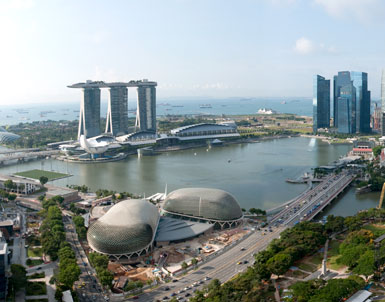
Marina Bay, 2015

Marina Bay, 1977
Marina Bay was planned as a seamless extension to Singapore's Central Business District (CBD) at Raffles Place and to realise the vision of a Garden City by the Bay. It is envisioned as a vibrant 24/7, environmentally-friendly place where people can live, work and play.
3.5km long waterfront promenade
Marina Bay's 3.5km long waterfront promenade, which includes the Helix Bridge and Jubilee Bridge, provides visitors with a seamless, barrier-free walking experience to the necklace of attractions around the Bay.
1970s
Reclamation of the Marina Bay area begins.
Live-Work-Play
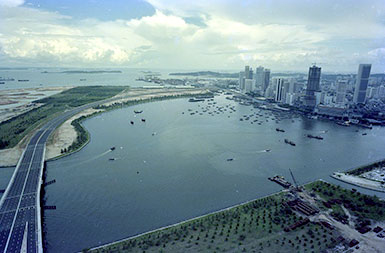
Marina Bay, 1981
Development parcels at Marina Bay are based on an urban grid pattern to ensure good connectivity while maintaining flexibility and efficiency in catering to different building types.
'White Site'
Sites at the Bay area are zoned ‘white’ to allow developers greater autonomy in creating developments to serve different uses such as housing, offices, shops, hotels, recreation facilities and community spaces.
Clifford Pier
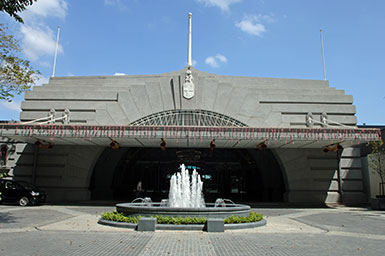
Clifford Pier, 2009
Officially opened in 1933, Clifford Pier replaced Johnston’s Pier as the first point of entry into Singapore for early immigrants.
Red Lamp Pier
As a guide to seafarers, a red oil lamp used to hang at the end of the pier so Clifford Pier is also affectionately referred to as Red Lamp Pier - 红灯码头 (Chinese), Ang Teng (Hokkien), Lampu Merah (Malay).
Fullerton Hotel
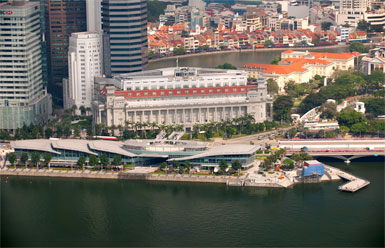
Fullerton Hotel & One Fullerton, 2011
Construction of the neoclassical building took approximately three years and it sat at the mouth of the Singapore River.
An Illustrious History
One of the most prominent historic architecture at Marina Bay, the building was once home to The Exchange, Chamber of Commerce, The Singapore Club, various government agencies, and was used as a hospital before serving as the nation’s General Post Office. It was redeveloped into The Fullerton Hotel in 1997.
3D Skyline
The signature skyline of Marina Bay’s Financial Centre is the result of careful sculpting to create a unique three-dimensional layered effect with lower buildings in front and taller buildings at the back.
Tallest Buildings in Marina Bay
Year
|
Building
|
Height
|
|---|
| 1955 |
Former Asia Insurance Building
| 87 metres |
| 1996 |
Millenia Tower
| 218 metres |
| 2010 |
Marina Bay Financial Centre Tower 2
The Sail @ Marina Bay
| 245 metres |
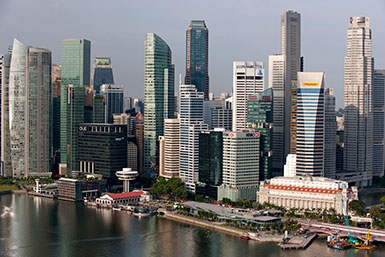
CBD skyline, 2013
Reaching New Heights in Entertainment
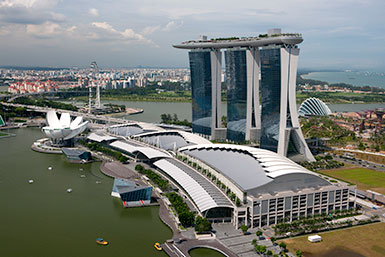
Marina Bay Sands, 2012
Opened in 2010, Marina Bay Sands consists of three 55-storey hotel blocks, and various entertainment, dining and recreational attractions such as the ArtScience Museum and The Shoppes within its vicinity.
It is topped off by a SkyPark that measures 340m, which is as long as the height of the Eiffel Tower!
Gardens by the Bay

Aerial view of Gardens by the Bay
Photo credit: Gardens by the Bay
Gardens by the Bay was designed with environmental sustainability in mind. Several of the Supertrees have photovoltaic cells on their canopies to harvest solar energy for lighting at night, while horticultural waste from the Gardens and around Singapore is used as a fuel source to cool the Flower Dome and Cloud Forest. Rainfall and water run-off from the Gardens are captured in the lakes and naturally cleansed by aquatic plants before being discharged into Marina Reservoir. The Gardens has transformed what was once barren land reclaimed from the sea into a thriving ecosystem teeming with biodiversity. It offers a glimpse into a sustainable future where urban development co-exists in harmony with nature.
Reservoir in the Heart of the City
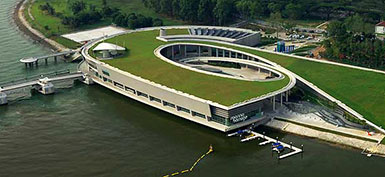
Aerial view of Marina Barrage
Photo credit: PUB
Marina Barrage was built across the mouth of the Marina Channel, creating Singapore’s 15th reservoir and the first in the heart of the city.
Water Catchment Area
- 10,000 hectares – one-sixth the size of Singapore
- Largest and most urbanised catchment on the island
Esplanade - Theatres on the Bay
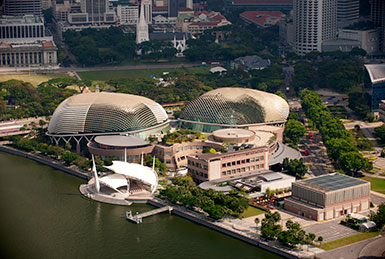
Esplanade - Theatres on the Bay, 2011
Completed in 2001, The Esplanade consists of a concert hall and performing arts theatre. The Esplanade’s concert hall is one of the world’s most advanced performance venues with state-of-the-art acoustics.
Marina Bay - How Much Do You Know?
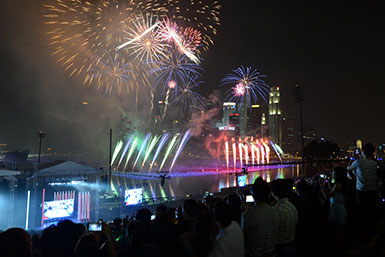
Fireworks at Marina Bay
360 hectares of land (size of 400 soccer fields)
40 Years
The time it took to build Marina Bay to what it is today.
People’s Bay
Marina Bay plays host to countless celebrations and events like Marina Bay Singapore Countdown, River Hongbao, National Day Parade, F1 Singapore Grand Prix Night Race, 2010 Summer Youth Olympics.
Visit Marina Bay’s Website to find out more
Preserving Our Memories
Conserving Our Architectural Gems
From the 1970s to 2014, we have conserved close to 7,200 buildings and structures island-wide. These physical anchors build up our identity as a nation, act as markers of our social history and as a repository of collective memories, and help cultivate the city's character. We have conserved various buildings and structures such as shophouses, skyscrapers like the former Asia Insurance Building, schools like St Patrick's School, and structures like Cavenagh Bridge and the bandstand in the Singapore Botanic Gardens.
3R Principle in Conservation
- Retention – Original structure and architectural elements are retained as much as possible.
- Restoration – Extensive research is done to ensure that the restorations are compatible to the building's original design and spirit.
- Repair – Careful repair works are done to structures and fixtures to enhance safety while replicating original designs.
Visit URA’s Website to find out more
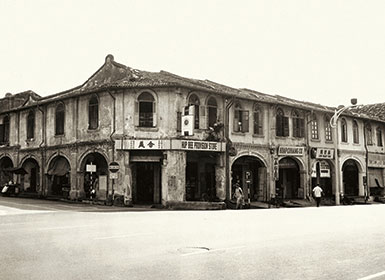
One of the first efforts at conservation was undertaken in Emerald Hill. Pictured here are shophouses in the 1700s prior to conservation.
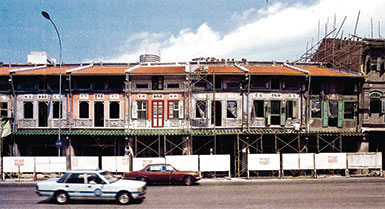
In 1987, URA led the way in conservation by restoring the first 32 units in Tanjong Pagar to keep their unique architectural style.